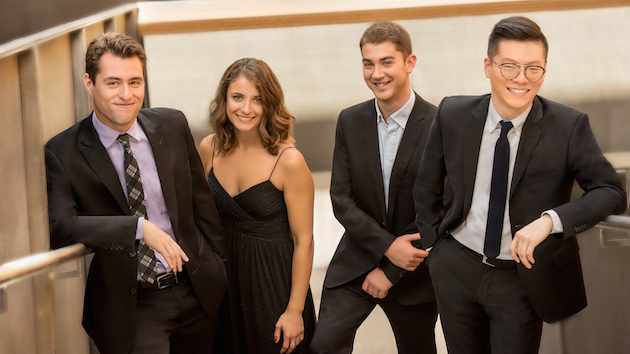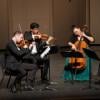
The Dover Quartet won the 2013 Banff International String Quartet Competition, and since then, anyone who’s talked about the young group has done so in hushed, reverent tones. I’ll be more outspoken, but no less reverent: on Sunday, I finally got to hear the group play — at Herbst Theatre. From the first notes, it was the most stunning performance I’d heard of Britten’s first quartet — and probably of any Britten work.
I almost wished they had saved it for last, but, followed by a middle Bartók quartet (No. 3) and Dvořák’s last quartet (No. 14), the program made a nice arc. In fact, playing without preamble, the Britten — whose opening smears together the three upper voices in pulsing sound masses — accentuated the uniqueness of this composer’s first contribution to the genre.
Blending their individual sounds in a way that downplayed the strangeness of the timbre, Dover’s performance actually heightened Britten’s magic. This initial recurring motif never sounded like two violins plus a viola playing high up; it was one entity, against a melody that simply happened to be played without the bow. In the same way, the level bowing and pizzicato of the two lower voices (violist Milena Pajaro-van de Stadt and cellist Camden Shaw) created a homophony that sounded new. Shared lines didn’t feel passed; they just were.

It’s difficult enough to execute Britten’s score, and it’s a special occasion to get to hear such finer points — the capriciousness of the second movement, or the continuous quality of the slow movement, with long-breathed melodies by first violinist Joel Link. In fact, after this monumental Andante, the last movement can feel inconsequential — but in a committed and well-paced performance (especially regarding the little nods to Beethoven’s Op. 131), Dover was a force of joy.
The Bartók was as strongly characterized, if by elusiveness. The compact work makes much of only a few motives, and yet, no matter how many times an idea repeats, the feeling remains inconclusive. It’s not only that the moods shift — they hardly have enough time to form.
A uniquely directional introduction heightened the chaos of the rest of the piece. Purpose and a strong sense of pulse organized the music, the sound warm and fully present. Then, the rest: angular and breathless, the gestures overwhelming, particularly in the coda (a “rollicking sleigh ride,” Shaw said). The atmosphere was deliciously taut.
Dvořák’s Quartet in A-Flat, then, was like a wrapped present. In fact, the work represents a major culmination: including unnumbered works, the composer wrote as many quartets as did Beethoven. Many of them are dense. Dvořák’s music often seems maximally orchestrated, so playing the lone melody line can feel like bushwhacking — and the brambles, which are awkward to play, will almost always be too loud.
This music always sounds busy on some level, but on Sunday, careful balance made the intricate accompanying figures shine. (Indeed, Dover makes me hopeful for great performances for the composer’s thorny early quartets.) Throughout the performance, but particularly at the end of the slow movement, second violinist Bryan Lee imbued the rhythmic noodles with importance, elevating them to the level of counter-melody.
In fact, Dover’s performance had a kind of pureness or classicism; it was still Dvořák, but played to sound simpler, as if after Schubert songs. Seamless bow changes made some phrases overlap into perpetuity — yet other moments evaporated, or breathed, as if sung. Nothing was overblown, and it struck me that Op. 105 wasn’t the “American” or “Czech” or “Slavonic” quartet; it was simply a great quartet, played by a great quartet.




